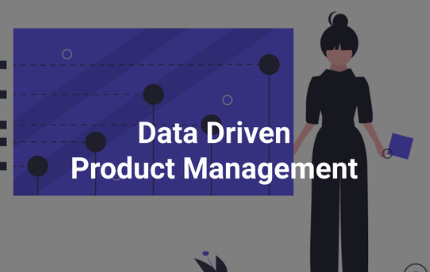Hello Product People, This week’s newsletter is brought to you by Orbital
Orbital is how remote teamwork should feel! The same link for all meetings, chats, or coworking, with unlimited breakouts. Your space can be fully customised with graphics and interactive tools. Enjoy the benefits of being together, no matter where you are in the world. Get it for free.
What is a data product manager?
A data product manager is similar to other product managers, but with one key difference: they put data at the heart of everything they do. Data PMs are responsible for designing products and features that are based on advanced data-driven insights, but it’s also their job to leverage the flow of data, too.
Using data to inform product design is nothing new. In fact, one of the earliest stages of product development is customer research — the results of which help shape a product.
As the world has become ever more data-driven, the collection of customer insights has likewise become more common. It’s the role of the data PM to find a way to tap into these data streams within product features.
They’re no longer tools used to build a feature, but rather are deeply integrated into the features themselves.
The benefit of being a data product manager
It’s clear that the data product manager role is becoming more valuable
As our understanding and leverage of real-time data increases, so too will the demand for product managers who understand exactly how to use it to a business’s advantage.
Here are 4 core ways a data product manager can bring value to a product development team:
Product teams can fully utilize the many data-rich solutions available via modern technologies, including GPS, biometrics, and more. These real-time data sources enable new levels of interactivity and functionality, to improve the user experience and value of a product.
The role of the data analyst is decoupled and merged with product development, meaning data is no longer a siloed one-use commodity, but a real-time data-stream to be tapped.
The product team no longer needs to guess how customers interact with a product because real-time data-driven insights can be prototyped and tested before being deployed.
A data product manager eliminates the risk of using bad or outdated data to make decisions. With access to limitless data insights, the team’s decision-making becomes more proactive and less reactive.
What is Data-Driven Decision Making
Data-driven decision-making (sometimes abbreviated as DDDM) is the process of using data to inform your decision-making process and validate a course of action before committing to it.
In the product world, this is seen in many forms. For example, a company might:
Collect survey responses to identify products, services, and features their customers would like
Conduct user testing to observe how customers are inclined to use their product or services and to identify potential issues that should be resolved prior to a full release
Launch a new product or service in a test market in order to test the waters and understand how a product might perform in the market
Analyze shifts in demographic data to determine business opportunities or threats
How exactly data can be incorporated into the decision-making process will depend on a number of factors, such as your business goals and the types and quality of data you have access to.
Examples of data-driven decision making
Today’s largest and most successful organizations use data to their advantage when making high-impact business decisions. To better understand how your organization can incorporate data analytics into its decision-making process, consider the success stories of these well-known businesses.
1. Leadership Development at Google
Google maintains a heavy focus on what it refers to as “people analytics.” As part of one of its well-known people analytics initiatives, Project Oxygen, Google mined data from more than 10,000 performance reviews and compared the data with employee retention rates. Google used the information to identify common behaviors of high-performing managers and created training programs to develop these competencies. These efforts boosted median favorability scores for managers from 83 percent to 88 percent.
2. Driving Sales at Amazon
Amazon uses data to decide which products they should recommend to customers based on their prior purchases and patterns in search behavior. Rather than blindly suggesting a product, Amazon uses data analytics and machine learning to drive its recommendation engine. McKinsey estimated that, in 2017, 35 percent of Amazon’s consumer purchases could be tied back to the company’s recommendation system.
How to Make Data-Driven Decisions
If you have a goal of becoming more data-driven in your approach to business, there are many steps you can take to reach that goal. Here's a look at some of the ways you can approach your daily tasks with an analytical mindset.
1. Look for Patterns Everywhere
Data analysis is, at its heart, an attempt to find a pattern within, or correlation between, different data points. It’s from these patterns and correlations that insights and conclusions can be drawn.
The first step in becoming more data-driven is making a conscious decision to be more analytical—both in business as well as in your personal life. While this might seem simple, it’s something that takes practice.
Whether you’re at KPIs dashboards, standing in line at the grocery store, or commuting on the train, look for patterns in the data around you. Once you have noticed those patterns, practice extrapolating insights and try to draw conclusions as to why they exist. This simple exercise can help you train yourself to become more data-driven in other areas of your life.
2. Tie Every Decision Back to the Data
Whenever you’re presented with a decision, whether business-related or personal in nature, do your best to avoid relying on gut instinct or past behavior when determining a course of action. Instead, make a conscious effort to apply an analytical mindset.
Identify what data you have available that can be used to inform your decision. If no data exists, consider ways in which you could collect it on your own. Once you have the data, analyze it, and use any insights to help you make your decision. As with the pattern-spotting exercise, the idea is to give yourself enough practice that analysis becomes a natural part of your decision-making process.
3. Visualize the Meaning Behind the Data
Data visualization is a huge part of the data analysis process. It’s nearly impossible to derive meaning from a table of numbers. By creating engaging visuals in the form of charts and graphs, you’ll be able to quickly identify trends and make conclusions about the data.
Got anything interesting to add? Share your thoughts in the comment section below.







